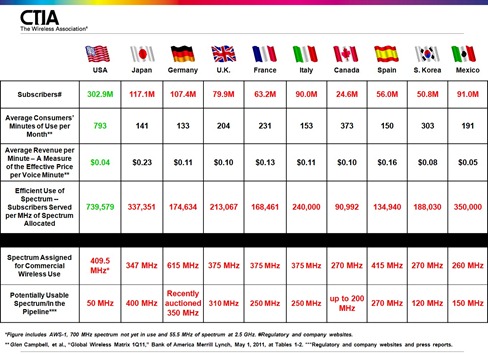While commentators on this site and others love to hate the seeming capriciousness of wireless service pricing, a recently released country-by-country comparison from CTIA, the wireless industry lobby, shows that we might not have it as bad as we think.
The U.S. has the most subscribers of any other country at 302.9 million, followed by Japan with less than half as many at 117.1 million. And U.S. cell phone customers use more minutes on average than any other country’s subscribers at 793 minutes per month, followed by France at just 231. Yet the average price of a minute in the U.S. is the lowest of any country, at four cents. Compare that to 23 cents in Japan and 13 cents in France.
(MORE: Overage Fees Are Good for You, Says the Wireless Industry)
What would be interesting to see are country comparisons for data pricing. It may well be that foreign countries use less minutes because they’re substituting them for data. A CTIA spokesman said that such a comparison is not readily available, though the Organization for Economic Cooperation and Development may be putting one together.
Aside from prices, the most interesting—and alarming—thing about the comparison is how much radio spectrum is poised to be available for wireless. On that front, the U.S. is dead last with only 50 MHz becoming available soon. That spells trouble because the carriers are facing a spectrum crunch as they already serve more customers per megahertz of spectrum available to them than any other country by a wide margin.
Senate Majority Leader Harry Reid proposed allowing the FCC to auction spectrum now held by broadcasters as part of the recent debt ceiling deal. That proposal, however, failed to make it to the final bill.
MORE: They Should Make It: Cheap Smartphones, Free Service
Jerry Brito is a contributor to TIME. Find him on Twitter at @jerrybrito. You can also continue the discussion on TIME’s Facebook page and on Twitter at @TIME.


